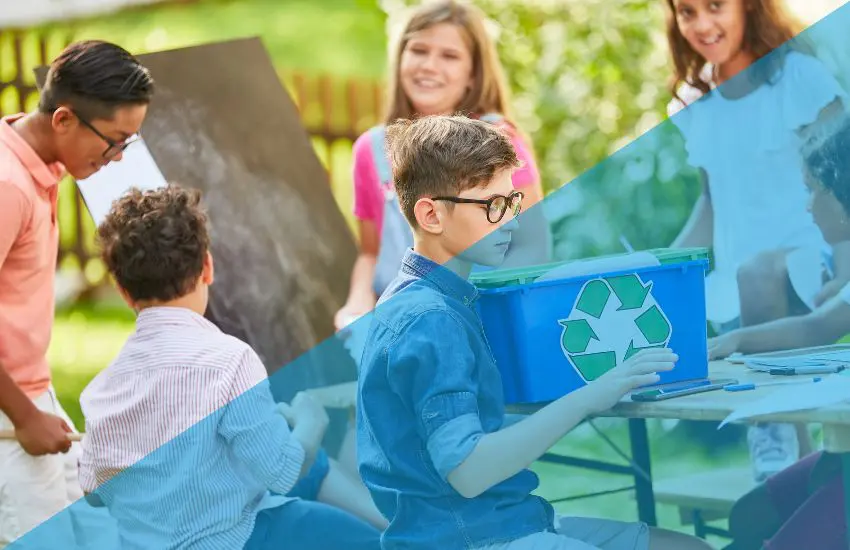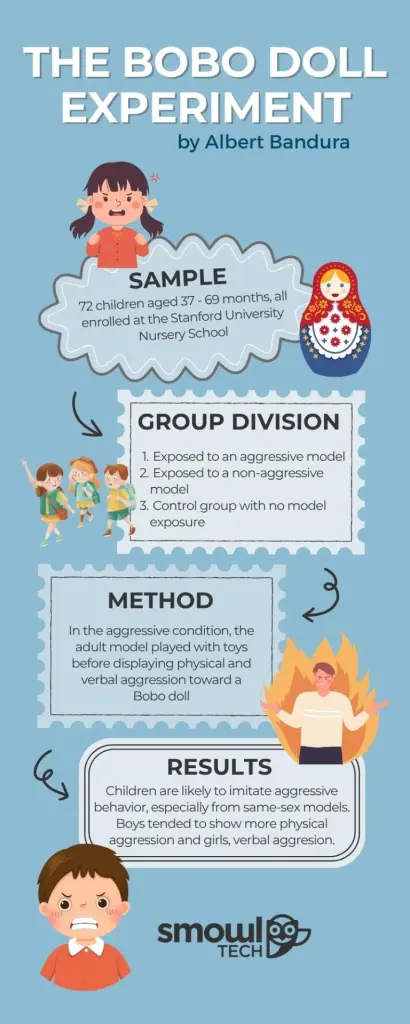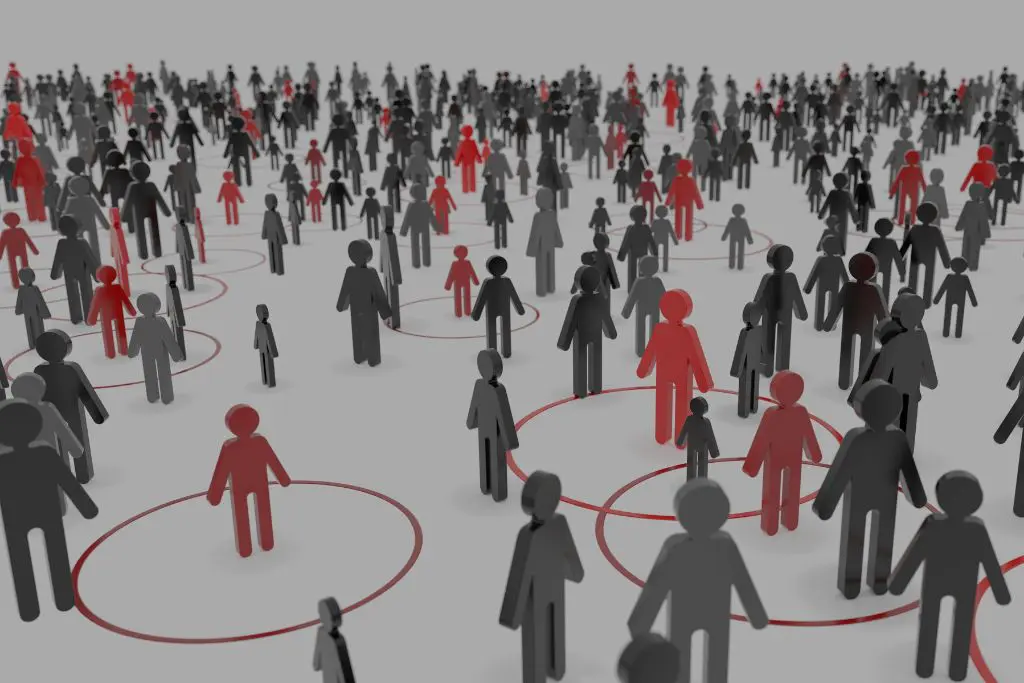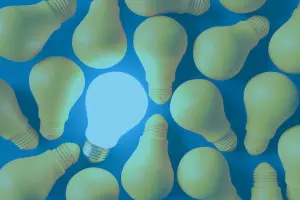Social learning considers not only the environment in which a person develops but also their motivation and personal attributes when assimilating knowledge.
In this approach, the role of updating learning with new ICTs (Information and Communication Technologies) becomes highly relevant.
Given its importance, let’s explore what social learning is, from its origins to its applications.
What is the Social Learning Theory?
It´s a psychological theory developed by Albert Bandura that explains how individuals develop new behaviors, attitudes, and emotional responses by observing and imitating others.
What is the main idea of Social Learning Theory?
It emphasizes that learning is a cognitive process that takes place in social settings and can happen through observation or instruction, even without direct experience or practice.
In addition to watching behaviors, individuals also learn by observing the outcomes of those behaviors.
When actions are consistently rewarded, they are more likely to continue; when punished, they are likely to decrease.
Relevance of the Social Learning Theory
Bandura´s approach is widely used in psychology, organizational settings, and education, where the learner assumes an active role at the center of the educational process while the teacher transforms their informative role into an educational one, guiding the student in participating in their own evolution.
Social learning theory is particularly relevant in today’s media-driven world, where individuals not only learn from face-to-face interactions but also continuously observe and adopt behaviors through digital and online platforms.
Social Learning Theory: origin
The theory of social learning originated at the beginning of the 20th century.
However, it was propelled by Albert Bandura in the second half of the century. This psychologist concluded that an individual learns through imitation and that the person’s characteristics and motivation come into play to make that behavior repetitive.
Social learning theories: background
Early behaviorists like B.F. Skinner and Clark Hull emphasized stimulus-response models and operant conditioning to explain learning, including language acquisition.
Skinner argued verbal behavior was shaped by reinforcement, though he denied an innate imitation faculty.
Meanwhile, Neal Miller and John Dollard published their book “Social Learning and Imitation“ in 1941, which suggested that personality consisted of learned habits.
Julian Rotter later advanced these ideas by integrating behaviorist and cognitive concepts in his 1954 book “Social Learning and Clinical Psychology”.
In his theory, behavior was influenced by the interaction between the social environment and individual personality, with learning occurring through the reinforcement of these behaviors.
Although his terminology resembled that of traditional behaviorism, his emphasis on internal processes and traits set his theory apart.
However, all these theories still struggled to explain the acquisition of new behaviors fully.
As a response, Albert Bandura explored learning processes that took place within social interactions, which he believed were inadequately addressed by the existing theories.
He initiated research on how individuals quickly acquire new behaviors through observation of others, with his most well-known work being the Bobo doll experiment.
In 1977, Bandura formalized these insights in “Social Learning Theory”.
His book combined elements of behavioral and cognitive learning theories to create a more comprehensive framework capable of explaining the diverse learning experiences encountered in everyday life.

The Bobo doll experiment
During the development of his theory, Albert Bandura conducted the Bobo Doll experiment.
The study sought to determine whether children were more inclined to imitate a model of the same sex and if boys would exhibit higher levels of aggression than girls when exposed to aggressive behavior.
Sample
The experiment involved 72 children aged between 37 and 69 months, all enrolled at the Stanford University Nursery School.
Prior to the experimental sessions, the researchers observed the children in the nursery to assess their baseline levels of aggression, using four 5-point rating scales.
To ensure balanced group assignment, the children were matched based on similar levels of everyday aggressive behavior.
To confirm the reliability of these initial aggression ratings, 51 children were independently assessed by two observers. The inter-rater reliability was high, with a correlation coefficient of r = 0.89, indicating strong agreement between observers.
Method
For the experiment, the children were divided into three groups: one-third were exposed to an aggressive model, another third to a non-aggressive model, and the remaining third served as a control group with no model exposure.
However, the test was conducted individually to limit stimuli and distractions.
In the experiment, different toys and distractions were placed in the experiment room, including a test doll or Bobo doll, an inflatable toy about one meter tall made of resistant materials such as plastic or vinyl.
Children were exposed to either an aggressive or non-aggressive adult model to prevent peer influence.
In the aggressive condition, the adult model played with toys before displaying physical and verbal aggression toward a Bobo doll, hitting it with a mallet, punching, kicking, and shouting aggressive phrases.
After this modeling phase, the child was moved to another room with attractive toys but was soon told they couldn’t play with them, inducing frustration.
The child was then taken to a final room containing toys and allowed to play for 20 minutes while being observed.
Researchers recorded four types of behavior: physical aggression (e.g., hitting or kicking the Bobo doll), verbal aggression (e.g., repeating aggressive phrases), use of the mallet in non-modeled aggressive ways, and other forms of aggression that did not directly imitate the model.
Results
The study concluded that children are more likely to imitate aggressive behavior they observe, especially from same-sex models. Boys tended to show more physical aggression, while girls were more likely to be verbally aggressive.
Based on the results obtained through a social-cognitive approach, Albert Bandura determined that human behavior results from the interaction between the individual and the environment.
Thus, the social learning theory considers that both external and internal factors interact in the learning process, distinguishing between active learning (learning by doing) and vicarious learning (learning by observing others).

Types of social learning
Three types of social learning combine to create the experience of knowledge assimilation:
- Observational learning: It occurs when a person observes the behavior of another individual and imitates it.
- Punishment-based learning: A specific behavior leads to negative reinforcement to prevent its recurrence.
- Reward-based learning: The aim is to motivate an individual to repeat a behavior by providing incentives.
Social learning implies a paradigm shift in knowledge acquisition, where the learner is placed at the center and the role of the teacher moves away from being a mere transmitter.
In other words, the teacher gradually influences the student’s education to hand over control of their learning.
In this process, the teacher is no longer a source of information but a facilitator of evolution.
Do you want to stay on top of the latest trends in eLearning, EdTech, and Human Resources?
Fill out the form to receive our weekly newsletter with industry insights from our experts.
Principles of Social Learning Theory
It is important to understand that, according to Albert Bandura’s Social Learning Theory, for a behavior to be accurately imitated, four principles must be fulfilled:
- Attention: The learner must pay attention to the model they are imitating.
- Memory: The person learning must be able to retain the observed information in order to reproduce it.
- Reproduction: The student must have the appropriate context to reproduce the behavior, which doesn’t necessarily have to be identical.
- Motivation: Without interest, the chain of social learning breaks. To reinforce it, a reward or objective that gives meaning to the behavior reproduction needs to be introduced.
According to Albert Bandura, this reward can take different forms:
- Past reward or punishment: In response to a behavior that has been performed.
- Average reinforcement or punishment: Incentives sought by engaging in an activity.
- Vicarious reinforcement or punishment: The individual desires to achieve or avoid what they see others receiving.
In this way, we are referring to social and emotional learning, in which individuals acquire knowledge, understand and manage emotions, and develop skills such as empathy, anticipation of outcomes, responsible decision-making, and the reinforcement of autonomy, among others.

The social learning approach: applications
Social Learning Theory has broad applications in today’s world.
For example, in therapy, it aids behavior change by reinforcing positive behaviors. In workplaces, it guides employee training, leadership development, and teamwork through observation and imitation.
With regards to education, it supports learning through modeling and peer interaction. Let’s explore more deeply how Bandura’s theory can be applied across the various contexts mentioned.
Social learning in psychology
Bandura’s Social Learning Theory remains highly influential in modern psychology and therapy.
It underpins many cognitive-behavioral approaches by emphasizing the role of observational learning, modeling, and reinforcement in behavior change.
Therapists often use modeling to demonstrate positive coping strategies, helping clients adopt healthier behaviors through imitation.
Group therapy and role-playing also draw on these principles, allowing clients to learn from others in social contexts.
Social learning in corporate settings
Social Learning Theory is widely applied in the workplace to enhance training, leadership development, and team dynamics.
Employees often learn by observing supervisors, mentors, or peers, making modeling a key strategy in onboarding and skills training.
Positive behaviors, such as collaboration, problem-solving, and professionalism, are reinforced through recognition and rewards, encouraging imitation.
The theory supports mentoring programs, where experienced staff model successful work habits and attitudes.
It also explains how workplace culture influences behavior, as employees adapt to shared norms.
Additionally, Social Learning Theory guides organizational change strategies by using influential role models to promote new behaviors and drive cultural shifts.

Social learning in education
Considering everything discussed earlier, it is easy to see the value of applying social learning in education, especially in light of the learning revolution brought about by ICTs.
It becomes a tool that can help students become active participants in their learning, setting goals to guide their educational development.
At the same time, it strengthens the bond between teacher and student, fostering a positive attitude towards learning and managing frustrations.
Through virtual classrooms, video tutorials, social networks, and Learning Management Systems (LMS), e-learning plays a vital role in generating new ways of acquiring knowledge, such as ubiquitous learning.
At Smowltech, we aim to be part of this educational revolution by offering highly customizable proctoring plans to our clients. Discover how we can assist you by requesting a free demo.
Updated on
FAQ – Social Learning Theory
What is social learning?
Social learning is the process through which people gain new behaviors, knowledge, and attitudes by watching, mimicking, and engaging with others in their social environments. It highlights the importance of observation, indirect (vicarious) learning, and reinforcement in influencing and shaping individual behavior.
What is the history of Social Learning Theory?
The Social Learning Theory emerged in the mid-20th century, evolving from behaviorist theories.
Albert Bandura later advanced the theory by emphasizing observational learning, modeling, and cognitive processes, notably through his Bobo doll experiment in the 1960s. His 1977 book “Social Learning Theory” formally outlined these concepts, solidifying the theory’s place in modern psychology.
What does Bandura´s Social Learning Theory say?
Bandura’s Social Learning Theory suggests that individuals learn new behaviors by watching others, especially when those behaviors are rewarded.
The theory emphasizes the significance of observation, imitation, and modeling, asserting that four key factors — attention, memory, reproduction, and motivation — must be present for a behavior to be effectively imitated.
What was the Bobo doll experiment about?
The Bobo doll experiment, conducted by Albert Bandura in the 1960s, studied how children learn aggression through observation.
Children who watched an adult behave aggressively toward a Bobo doll (an inflatable, egg-shaped toy with a weighted bottom that causes it to return upright when knocked over) were likely to imitate that behavior, demonstrating that observation can lead to the learning of new behaviors.







